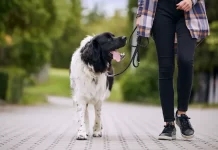Heat stroke and pad burns are two most common problems your dog might suffer in summer if you aren’t careful. As a pet owner, you should know how to protect your furry friend and ensure their comfort when the hot weather starts. Learn how to cool your dog right and change your walking routine if the place you live in is particularly dangerous in this regard.
Table of Contents
How to Protect Your Dog from Summer Heat
1. Cooling Your Pet Down
Keep the dog’s coat trimmed if it spends a lot of time outdoors and the breed is naturally furry. As today pet owners can have any kind of dog, people tend to forget that animals struggle with adapting to climate changes much more than humans do. As they aren’t able to put on a sundress or warm jacket, it’s the owner’s duty to prepare their pet to face the challenges of local weather.
That’s why you need to research the dog breed and provide them with proper grooming and care. Breeds with thick long or curly coat will need regular trims. However, some types of curly breeds can manage quite well in the heat, among those you can count Poodle and Labradoodle. On the other hand, dogs with short thick coats, like Chihuahua or Maltese do not tolerate heat well and trimming won’t help them much. The same goes for all dogs with short noses as this shape of the skull doesn’t allow the animal to cool itself naturally. Breeds like this must be kept indoors in a cool environment.
If your dog starts showing the signs of a heat stroke (panting, hard breathing, drooling, weakness, etc.) cool it down with a shower or put wet washcloths dipped in cold water on the insides of animal’s thighs.
Note that if you use a shower, it should be lukewarm but not cold as that might put your pet into shock. Ice packs and the like are also to be avoided.
2. Change Walking Times
To protect your dog from heat stroke you should take it outdoors during the cooler hours. A midday walk is a definite no, unless you have a cool park or forest nearby. Exercising is best left for early mornings.
You should also choose the places for your walks more carefully. Asphalt heats up very much in the summer and might give your pet paw burns. This might happen even after the sun goes down as the material will keep the heat it absorbed during the day. Walk your dog on soft ground, like dirt roads and grassy patches.
Do not, under any circumstances, tether the dog outdoors for extended periods of time. If this cannot be avoided, provide the animal with a cool kennel or some other type of shed that will give them some shade.
3. Give the Pet More Water
The best way to protect your dog from heat stroke is to give it plenty of water and shade. You will need to refill the animal’s water bowl more often in hot weather, so keep an eye on it. If your dog spends a lot of time in the yard, keep a bowl of fresh water there as well.
You also should take a small plastic bowl and a bottle of water when you go out for a walk. These items are a must-have if you hike or drive somewhere with your pet. Watch your dog closely and give them some water as soon as they start panting.
Remember, if you leave the dog inside a car in hot weather, park in a shady spot. You also need to leave the windows open slightly to keep the air flowing and fill the dog’s travel bowl with water. Do not leave the animal inside a vehicle for more than a few minutes.
The temperature in a car will spike very fast, so only leave your pet there in extreme situations and be aware that this is extremely dangerous!
















